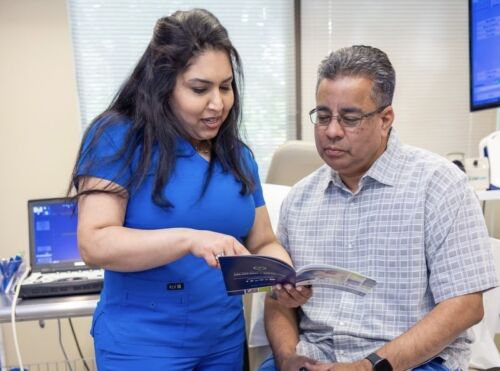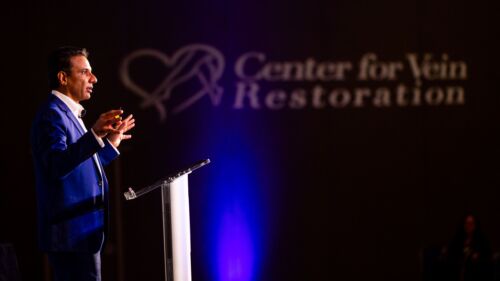Varicose veins are a common condition that affects both men and women. Females, however, are more likely to develop these painful and unsightly enlarged leg veins. Learn why.
A type of vein disease, varicose veins are caused by malfunctioning tiny one-way valves that control blood flow through the veins. When these valves do not work correctly, blood can flow backward and pool in the veins, causing swelling, itching, cramping, and enlarged and twisted veins.
According to the AHA Journal Circulation, approximately 23 percent of U.S. adults have varicose veins, affecting 22 million women and 11 million men between the ages of 40 to 80 years.
How do varicose veins feel?
While some people with varicose veins may not suffer debilitating symptoms, others may experience leg pain, discomfort, swelling, cramping, and aching in the affected area. In some cases, varicose veins can lead to more consequential complications, such as skin ulcers and deep vein thrombosis (DVT). Early diagnosis and treatment of vein disease can help prevent these conditions from becoming more serious—for both sexes.
Although there are many ways vein disease is a similar experience among males and females, there are vital differences women should understand regarding varicose veins.
Women are at higher risk for developing varicose veins
Studies show women are at a higher risk of developing varicose veins than men. According to the U.S. Department of Health and Human Services, Office of Women's Health, women are more likely to have varicose veins and spider veins. In a study from Southern California reported by the Vascular Disease Foundation, venous problems were present in 33 percent of women and 17 percent of men.
In another study reported by the NIH National Library of Medicine National Center for Biotechnology Information, the prevalence of varicose veins in Western populations was found to be about 25 to 30 percent of women and 10 to 20 percent of men.
Female hormonal changes and varicose veins
The increased risk for women developing varicose veins is partly due to hormonal changes, such as during pregnancy, menopause, and hormonal birth control use, that can weaken the valves in the veins.
Additionally, pregnancy can increase the blood volume in a woman's body by as much as 20 percent. Coupled with the weight of a growing uterus, the extra pressure on the leg veins can cause veins to enlarge and become varicose. Pregnancy hormones can also cause veins to dilate, making it harder for blood to flow back to the heart. And while varicose veins can be temporary and shrink after the baby is born, the risk of developing permanent varicose veins increases with each pregnancy.
Women are more likely to develop varicose veins as they age
While aging is the most significant risk factor for varicose veins in both sexes, women experience a greater increased risk of varicose veins symptoms as they age compared to men. Women aged 65 and older have an 83 percent chance of developing varicose veins symptoms. Men in the same age range have a 28 percent risk of developing the same symptoms.
Genetics and varicose veins
Research shows that a genetic predisposition
leaves some people (men and women) more prone to blood clots. Furthermore, once a person has had a blood clot in their leg, they are at increased risk for developing varicose veins.
How can women reduce their risk of developing varicose veins?
Although there are several risk factors for developing varicose veins that women cannot control, such as hormones, aging, and genetics, other risk factors for developing varicose veins are within a women's power. Regular exercise, maintaining a healthy weight, and avoiding prolonged standing or sitting can all help prevent the distressing condition.
What should women at high risk of vein disease do?
If you have varicose veins or suspect that you may have vein disease, it is essential to seek medical advice. Early diagnosis
and treatment can help prevent symptoms from worsening. After an examination, your healthcare provider may recommend venous Doppler ultrasound of your legs to "see" the speed of your blood flow and detect any blockages or clots. Based on the result of this test, your vein specialist may recommend treatment to improve blood flow.
Treatment for varicose veins
Treatment options offered at the 100+ Center for Vein Restoration (CVR) vein clinics are minimally invasive and performed in a comfortable office by highly experienced, board-certified vein doctors. The best treatment option will depend on the severity of the condition and your individual needs.
Treatment is covered by most insurance, including Medicare and Medicaid.
Call a helpful CVR Patient Services Representative at 240-965-3915 with questions or to schedule an appointment. You may also book an appointment ONLINE, 24 hours a day, seven days a week.

 About Vein Disease
About Vein Disease
 Spider Veins
Spider Veins
 Varicose Veins
Varicose Veins
 Vein Disease Treatments
Vein Disease Treatments
 Treating Spider Veins
Treating Spider Veins
 Treating Varicose Veins
Treating Varicose Veins
 About Us
About Us
 Patient Resources
Patient Resources
 Physician Resources
Physician Resources


